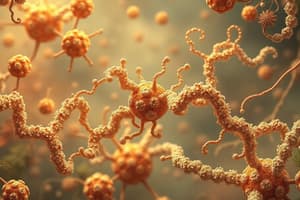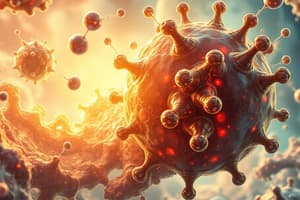Podcast
Questions and Answers
How do enzymes increase the rate of a reaction?
How do enzymes increase the rate of a reaction?
Enzymes increase the rate of reaction by lowering the activation energy required for the reaction to start.
Explain the 'lock-and-key' hypothesis of enzyme action.
Explain the 'lock-and-key' hypothesis of enzyme action.
The 'lock-and-key' hypothesis suggests that an enzyme (the lock) has a specific active site that perfectly fits a specific substrate (the key), allowing the reaction to occur.
How does temperature affect enzyme activity?
How does temperature affect enzyme activity?
Enzyme activity increases with temperature up to an optimum point. Beyond this point, the enzyme's activity decreases rapidly as it denatures.
What is an enzyme-substrate complex and why is it important?
What is an enzyme-substrate complex and why is it important?
Explain what enzyme denaturation is, and name two factors that can cause it.
Explain what enzyme denaturation is, and name two factors that can cause it.
Why are enzymes described as being highly specific?
Why are enzymes described as being highly specific?
How do cells overcome the challenge of breaking down large, insoluble food molecules?
How do cells overcome the challenge of breaking down large, insoluble food molecules?
What role do enzymes like catalase play in protecting cells?
What role do enzymes like catalase play in protecting cells?
Distinguish between anabolic and catabolic reactions, and explain the role of enzymes in each.
Distinguish between anabolic and catabolic reactions, and explain the role of enzymes in each.
How does pH affect enzyme activity, and why is this important in biological systems?
How does pH affect enzyme activity, and why is this important in biological systems?
If an enzyme is exposed to a pH significantly outside of its optimal range, how might this affect its function?
If an enzyme is exposed to a pH significantly outside of its optimal range, how might this affect its function?
Explain why only a small amount of enzyme is needed to catalyze a reaction.
Explain why only a small amount of enzyme is needed to catalyze a reaction.
Describe how enzymes are classified.
Describe how enzymes are classified.
Explain why enzyme activity decreases at both very low and very high temperatures.
Explain why enzyme activity decreases at both very low and very high temperatures.
How do high temperatures and extreme pH levels cause an enzyme to denature?
How do high temperatures and extreme pH levels cause an enzyme to denature?
What is the significance of enzymes being produced only when they are needed?
What is the significance of enzymes being produced only when they are needed?
Describe the relationship between enzyme concentration and the rate of reaction, assuming substrate is not a limiting factor.
Describe the relationship between enzyme concentration and the rate of reaction, assuming substrate is not a limiting factor.
Outline the steps involved in an enzyme-catalyzed reaction.
Outline the steps involved in an enzyme-catalyzed reaction.
Explain how the induced fit model differs from the lock-and-key model of enzyme action.
Explain how the induced fit model differs from the lock-and-key model of enzyme action.
What are digestive enzymes involved in digestion?
What are digestive enzymes involved in digestion?
Flashcards
What are enzymes?
What are enzymes?
Biological catalysts, typically large biological molecules made of proteins.
What is a catalyst?
What is a catalyst?
A substance that speeds up a chemical reaction without being chemically changed itself.
What are enzymes made of?
What are enzymes made of?
Proteins that function as biological catalysts, speeding up chemical reactions in cells.
How do enzymes lower activation energy?
How do enzymes lower activation energy?
Signup and view all the flashcards
Why are enzymes needed for digestion?
Why are enzymes needed for digestion?
Signup and view all the flashcards
What are digestive enzymes?
What are digestive enzymes?
Signup and view all the flashcards
What does amylase digest?
What does amylase digest?
Signup and view all the flashcards
What does protease digest?
What does protease digest?
Signup and view all the flashcards
What does lipase digest?
What does lipase digest?
Signup and view all the flashcards
What are anabolic reactions?
What are anabolic reactions?
Signup and view all the flashcards
What are catabolic reactions?
What are catabolic reactions?
Signup and view all the flashcards
How do enzymes break down glucose?
How do enzymes break down glucose?
Signup and view all the flashcards
How does catalase protect cells?
How does catalase protect cells?
Signup and view all the flashcards
How are enzymes classified?
How are enzymes classified?
Signup and view all the flashcards
Why are enzymes specific?
Why are enzymes specific?
Signup and view all the flashcards
What are substrates?
What are substrates?
Signup and view all the flashcards
Lock-and-key hypothesis
Lock-and-key hypothesis
Signup and view all the flashcards
What is optimum temperature?
What is optimum temperature?
Signup and view all the flashcards
What happens during denaturation?
What happens during denaturation?
Signup and view all the flashcards
What is optimum pH?
What is optimum pH?
Signup and view all the flashcards
Study Notes
- Biological catalysts are large biological molecules called enzymes
- A catalyst speeds up a chemical reaction without being chemically changed itself at the end
- Cells can rapidly break down carbohydrates, fats, or proteins using catalysts called enzymes without significantly raising body temperature
- Enzymes are biological catalysts made of protein molecules
- Enzymes catalyze the rate of chemical reactions without being chemically changed
- Enzymes provide an alternative pathway with lower activation energy to start a chemical reaction, for example, in the breakdown of glucose
Enzymes and Activation Energy
- Enzymes speed up the rate of chemical reaction by lowering the activation energy
- Some food molecules are large and must be broken down by enzymes into smaller substances to diffuse through the cell membrane
Digestive Enzymes
- Enzymes involved in digestion are known as digestive enzymes
- Examples of digestive enzymes:
- Amylase digests starch to maltose
- Maltase digests maltose to glucose
- Protease digests proteins to polypeptides, which are then digested to amino acids
- Lipase digests fats to fatty acids and glycerol
- Enzymes either build up or break down complex substances
Enzyme-Catalyzed Reactions
- Enzyme-catalyzed reactions can be classified into:
- Reactions that build up complex substances (anabolic reactions)
- Reactions that break down complex substances (catabolic reactions)
Anabolic Reactions
- Anabolic reactions build up or synthesize complex substances from simpler ones
- For example, amino acids taken into cells may be used to build up proteins, catalyzed by special enzymes in the cytoplasm
- In photosynthesis, glucose is synthesized from carbon dioxide and water and controlled by enzymes
Catabolic Reactions
- Catabolic reactions break down complex substances to simple substances
- For example, large food molecules are broken down into smaller molecules by digestive enzymes
- In cell respiration, glucose is broken down to release energy and form carbon dioxide and water through a series of chemical reactions, each catalyzed by a different enzyme
- Both plant and animal cells produce catalase to break down hydrogen peroxide into water and oxygen, removing its toxic effect
- Catalase is abundant in blood and the liver of mammals
- Enzymes catalyze reactions in an organism and are produced when needed
- Enzymes are classified according to the chemical reactions they catalyze:
- Carbohydrases digest carbohydrates
- Proteases digest proteins
- Lipases digest fats (lipids)
Enzyme Characteristics
- Enzymes are highly specific in their actions
- Each chemical reaction is catalyzed by a unique enzyme
- The 'lock-and-key' hypothesis describes that an enzyme is the lock, and the substrate is the key
- The substances on which enzymes act are substrates
- Enzyme reactions depend on the presence of active sites
- Active sites are grooves or 'pockets' on the surface of an enzyme molecule which the substrate molecule with the matching shape can fit
- When the substrate binds to the active site of the enzyme, an enzyme-substrate complex is formed
- It is a temporary molecule when substances bind to the enzyme
- Reactions take place at the active site to convert the substrate molecule(s) into product molecules
- The product molecule(s) separate(s) from the enzyme
- The enzyme molecule remains unchanged and is free to combine again with more substrate molecules
Enzyme Structure and Function
- Enzymes have a 3-dimensional shape with a depression called the active site
- Only a substrate with a complementary 3-D shape can fit into the active site, forming an enzyme-substrate complex
- While the substrate is attached to the active site, a chemical reaction occurs, and the substrate is converted to the products
- The products leave the active site, and the enzyme remains unchanged and can catalyze another reaction
- Enzymes have active sites complimentary to the shape of their substrates
- High temperature, acids, and alkalis can affect the shape of an enzyme and, consequently, its function
- Enzymes are used in minute amounts and remain unchanged at the end of reactions
- Enzymes are effective molecules, where the same enzyme can be used repeatedly and catalyze a large amount of substrate
Factors Affecting Enzyme Activity
- Enzymes are affected by temperature
- At low temperatures, enzymes are less active due to low kinetic energy
- As the temperature increases, the rate of enzyme reaction increases and effective collision is increased
- The optimum temperature is where the enzyme is most active
- Most human enzymes have an optimum temperature of about 40°C-45°C
- Increasing the temperature above the optimum temperature causes a rapid decrease in the rate of enzyme reaction, leading to denaturation
- The active site of the enzyme begins to lose its shape and is no longer complementary to the shape of substrate molecules, causing enzymes to lose their shape or denature
- Most enzymes are denatured at high tempuratures
Denaturation
- Denaturation is the change in the 3-D structure of an enzyme or soluble protein caused by heat or chemicals (acids/alkalis)
- Denaturation results in the loss or alteration of the enzyme's active site
- The substrate can no longer fit into the enzyme's active site, and no reaction will occur
- Enzymes are also affected by pH
- Some enzymes work best in acidic solutions, and others work best in alkaline solutions
- When enzymes are placed in pH conditions that vary from the optimum, they start to denature
- As the solution becomes acidic or alkaline from the optimum pH, its activity decreases
- At certain pH levels, the enzyme is completely denatured
Studying That Suits You
Use AI to generate personalized quizzes and flashcards to suit your learning preferences.




